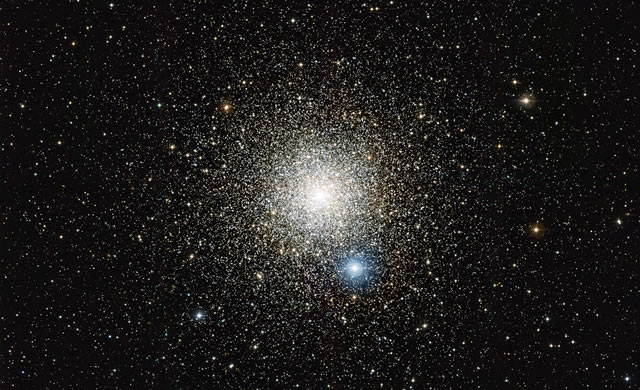
Gli astronomi si aspettano che le stelle simili al Sole espellano la gran parte dell’atmosfera nello spazio verso la fine della loro vita. Ma nuove osservazioni di un enorme ammasso stellare, effettuate con il VLT dell’ESO, hanno mostrato – contro ogni aspettativa – che la maggioranza delle stelle studiate semplicemente non raggiunge questo stadio nella propria vita. L’equipe internazionale ha trovato che la quantità di sodio nelle stelle è un indicatore molto chiaro di come esse arrivino alle ultime fasi di vita.
Da molti anni si ritiene di conoscere il modo in cui le stelle evolvono e concludono la propria vita. Modelli numerici dettagliati prevedono che le stelle di massa simile al Sole raggiungano un periodo verso la fine della propria vita – chiamato ramo asintotico delle giganti o AGB (asymptotic giant branch) – in cui le stelle attraversano un ultimo ciclo di combustione nucleare ed espellono la maggior parte della massa sotto forma di gas e polvere. Il materiale che viene espulso va a formare la successiva generazione di stelle e questo ciclo di perdita di massa e rinascita è fondamentale per spiegare l’evoluzione chimica dell’Universo. Il processo produce anche il materiale necessario per formare i pianeti – e anche gli ingredienti della vita organica. Ma quando l’esperto australiano di teorie stellari Simon Campbell, del Monash University Center for Astrophysics, di Melbourne, ha riletto alcuni vecchi articoli, vi ha trovato indizi allettanti sulla possibilità che alcune stelle possano in qualche modo sfuggire alle regole e saltare completamente la fase AGB. Egli stesso racconta: “Per un teorico della formazione stellare questo suggerimento era assolutamente pazzesco! Tutte le stelle passano attraverso la fase AGB secondo i nostri modelli. Ho ricontrollato tutti i vecchi studi e ho trovato che questo punto non era stato indagato adeguatamente. Ho deciso di studiare io stesso il problema, pur avendo scarsa esperienza osservativa.” Campbell e la sua equipe hanno usato il VLT (Very Large Telescope) dell’ESO per studiare in dettaglio la luce proveniente dalle stelle dell’ammasso globulare NGC 6752, nella costellazione australe del Pavone. Questa grande sfera di stelle antiche contiene sia la prima generazione di stelle che una seconda che si è formata un po’ più tardi. Le due generazioni si distinguono per la quantità di sodio che contengono – una misura che i dati di ottima qualità del VLT permettono di ottenere.
Fonte/Leggi tutto → ESO.org
Astronomers expect that stars like the Sun will blow off much of their atmospheres into space near the ends of their lives. But new observations of a huge star cluster made using ESO’s Very Large Telescope have shown — against all expectations — that a majority of the stars studied simply did not get to this stage in their lives at all. The international team found that the amount of sodium in the stars was a very strong predictor of how they ended their lives.
The way in which stars evolve and end their lives was for many years considered to be well understood. Detailed computer models predicted that stars of a similar mass to the Sun would have a period towards the ends of their lives — called the asymptotic giant branch, or AGB — when they undergo a final burst of nuclear burning and puff off a lot of their mass in the form of gas and dust. This expelled material goes on to form the next generations of stars and this cycle of mass loss and rebirth is vital to explain the evolving chemistry of the Universe. This process is also what provides the material required for the formation of planets — and indeed even the ingredients for organic life. But when Australian stellar theory expert Simon Campbell of the Monash University Centre for Astrophysics, Melbourne, scoured old papers he found tantalising suggestions that some stars may somehow not follow the rules and might skip the AGB phase entirely. He takes up the story: “For a stellar modelling scientist this suggestion was crazy! All stars go through the AGB phase according to our models. I double-checked all the old studies but found that this had not been properly investigated. I decided to investigate myself, despite having little observational experience.” Campbell and his team used ESO’s Very Large Telescope (VLT) to very carefully study the light coming from stars in the globular star cluster NGC 6752 in the southern constellation of Pavo (The Peacock). This vast ball of ancient stars contains both a first generation of stars and a second that formed somewhat later. The two generations can be distinguished by the amount of sodium they contain — something that the very high-quality VLT data can be used to measure.
Source/Continue reading → ESO.org





















